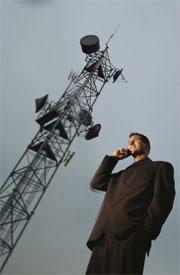 Signals from one cell phone mast to another get weaker when it's raining.© Getty
Signals from one cell phone mast to another get weaker when it's raining.© GettyThey have prompted protests at school gates, led to calls for planning procedures to be overhauled and have even been disguised as trees in the hope that people don't notice them. But now it seems that mobile-phone masts might inadvertently help to improve the accuracy of weather forecasts.
Research carried out by Hagit Messer and her colleagues at Tel Aviv University in Israel shows that it is possible to gauge rainfall by analysing the signal fluctuations of mobile-phone base stations. The group believes that by using information that is already collected by mobile-phone companies it should be possible to create much more accurate weather models. "What we are offering is better accuracy and better coverage," says Messer.
It is a well known phenomenon that rain can affect mobile-phone transmissions: droplets in the air reduce signal strength, with different-sized droplets affecting specific frequencies in the signal. This is so firmly established that base stations now automatically compensate for signal attenuations as the atmospheric conditions change, says Messer, whose work is published today in Science1.
Now Messer has shown that this compensation can reveal useful information. Using recordings of signal-strength fluctuations taken from calls being sent back and forth between base stations, the group were able to calculate the surface rainfall every 15 minutes during a rainstorm. These data were found to be comparable with direct rain measurements taken in Tel Aviv and Haifa.
Satellites, cars and bombers
This is not the first time that signal strengths have been used for sensing, says Anthony Illingworth, at the University of Reading's Department of Meteorology, UK. Signals from Global Positioning System (GPS) satellites have also been used to take atmospheric measurements. "Depending upon the humidity and temperature there can be slight delays in the signal," he says. These delays have been translated by some into weather data.
Mobile-phone signals themselves have also been harvested for other information in the past. Some researchers, such as Microsoft's Eric Horvitz, have looked at using such signals as a way of monitoring how much traffic is clogging the roads, simply by using mobile-phone transmissions as proxies for the number of cars. And in 1999 during the conflict in Kosovo, it is widely thought that some sort of disturbances in mobile-phone networks were used to help Serbian forces detect US Air Force F-117 stealth fighters, and shoot one down, when they couldn't be seen on radar.
ADVERTISEMENT
Previous research carried out by Graham Upton at Essex University, UK, had demonstrated the feasibility of using mobile-phone-like signal-strength fluctuations to measure precipitation. However, this involved using a purpose-built mock-up of a mobile-phone network, says Messer. The beauty of this latest work is that it shows how information that is already harvested by the mobile-phone companies could be recycled to help meteorologists. "We get this information for free," she says.
The hope now is that mobile-phone companies can be persuaded to part with this data without profiting from it, she says. In the meantime her group is working on refining the technique to distinguish between different types of precipitation such as rain, snow or hail.
Visit our phonessignalsrevealr.html">newsblog to read and post comments about this story.
